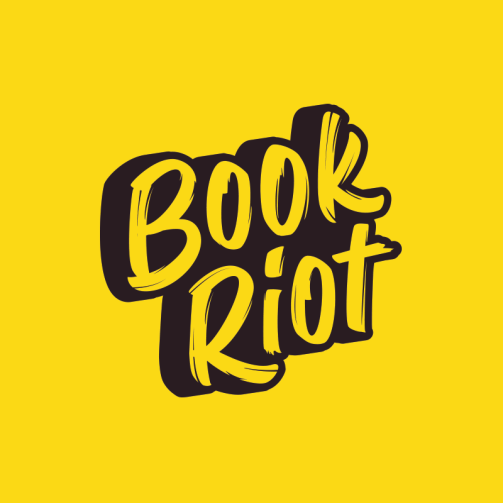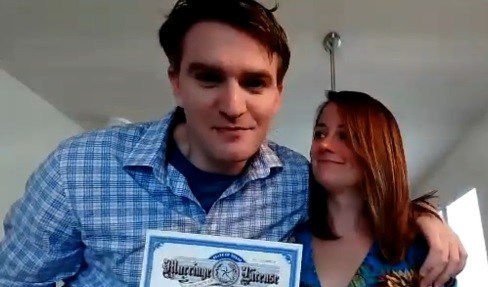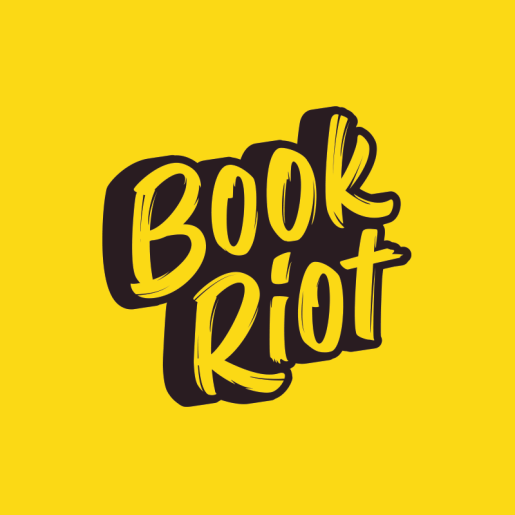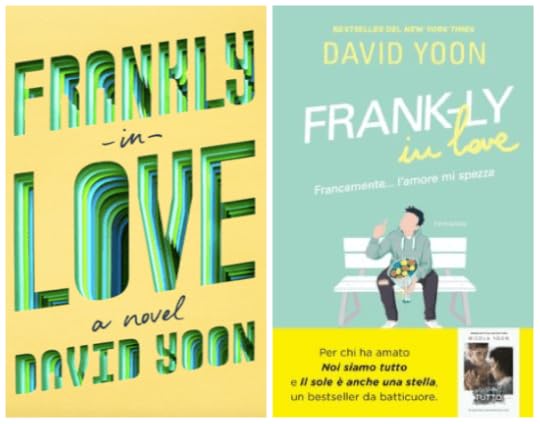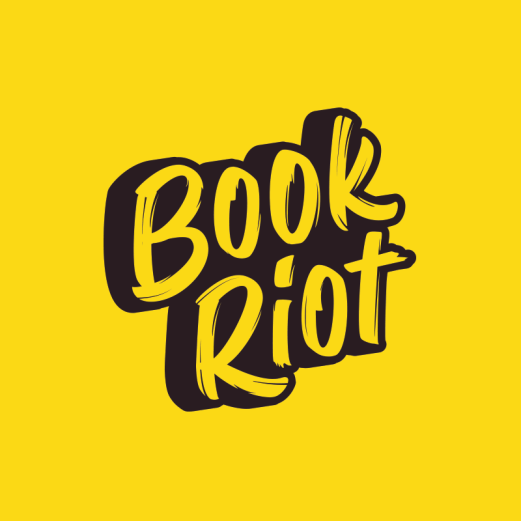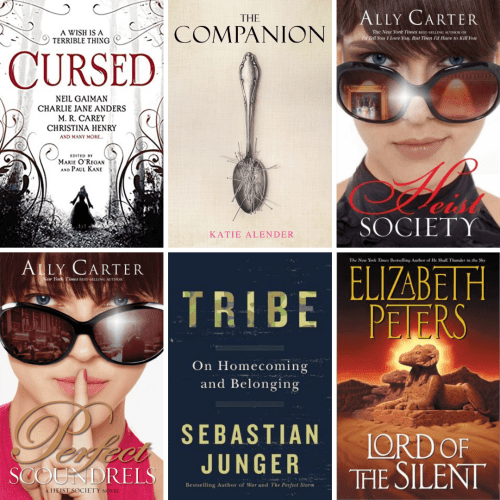Kelly Jensen's Blog, page 12
December 6, 2020
How To Support Your Favorite Online Writerrs
I shared this post last year around the same time, and given that this year’s losses for writers may have been even more difficult than last year’s, it felt like an appropriate piece to reshare. Money is, as always, helpful to support writers, but many of the ideas below are about a small time investment, rather than a financial one.
***
Over the last few months — weeks, really — we’ve seen a number of websites that book lovers adore cut their freelance writers and editors. Bustle’s books section lost its contributors and editors, and the Barnes and Noble genre blogs, including the teens blog, let their writers go. Both sites promise to continue producing content, but without savvy, insightful, and well-versed writers, they’ll never be the same.
Something I’ve thought about as an online writer is how these losses are painful, and while they’re not preventable (anyone in digital media knows this is a reality), there are things that readers can do to help with the longevity of these writers and sites. Too often, there’s a big mourning and public sadness about the loss of these sites. But, that same enthusiasm and engagement isn’t there continuously.
These suggestions aren’t going to be a fit for every person, nor will they fit in every situation. But they’re all small, manageable acts that you can do to show support for your favorite writers and editors in the bookish web.
Turn Off Your Browser’s Ad Blocker
The easiest and simplest way you can support writers you love online is to turn off your ad blockers. Yes, ads are annoying. They can slow down your computer a tiny bit. They are selling you things you may or may not be interested in. But those ads are what keep the lights on, whether you actively click on them or not.
You lose nothing by doing this or by – if your ad blocker supports this function – shutting it off for certain websites. Display ads make up a not insignificant amount of revenue for a website, and the fewer eyes that see them, the less likely advertisers will buy in, which reduces the revenue for websites, leading to cuts.
Think of it this way: display advertising on your screen is money in the pocket of those writers you love, even if you don’t click them.
Share Work You Love On Social Media
Seems obvious, but it’s not always the case. If you love something, share it among your social feeds. Clicks those garner not only bring in traffic to the site and, as noted above, more eyes on advertising, but that can help those writers gain exposure. As their reputations increase, so do the opportunities they might see when it comes to contributing in other capacities, be it another website in the future, a book, or even within their own company. If a writer is seeing good traffic, they’ll get more prime assignments or see their voices heard more frequently within the organization.
Too often, we forget that part of a writer’s livelihood is in their work being shared. If you’ve found something interesting or helpful, chances are someone else in your circle does.
Comment on Work You Love
Interacting with work you love is extremely helpful. It feels like it’s small, and it is. At least for you. For the writer, this interaction is not just a self-confidence boost, but it can be proof to an organization their work is important and valued.
While many sites have eliminated commenting directly on posts, most social media still allows it. Love a post? Go to the organization’s Facebook page and comment on the post. For Facebook, Twitter, and other algorithm-based streams, engagement increases a post’s chances of being seen by more people. A comment has more value than a thumbs up or like. Even something as simple as “this was a great read” can do wonders.
Leave Reviews (On Facebook, For Podcasts, etc.)
Facebook allows you to rate companies if they have a page, as opposed to a group. Rate the sites with work you love. Leave those five stars and write something about the value you see in that organization’s work.
For writers who are responsible for more than writing on-site content, leave reviews of their other projects. For example: is one of your favorite writers also a podcast host? Go to Apple Podcasts, to Spotify, to Stitcher, to Google Play, and to any other podcatcher of your choice and leave a positive review. Those reviews help increase the podcast’s visibility on those services, bringing in more listeners, which translates into both more traffic and more ad revenue.
If leaving reviews everywhere feels daunting, one thing I’ve found helpful is to set aside one day a month to spend 30 minutes leaving reviews everywhere I can think of. That’s it! It doesn’t need to be daily, doesn’t need to be a big project. Just a set period of time to do it and be done.
Click The Links On Posts
Most websites you read that link to products are using affiliate links, meaning that they get a small percentage of any sale made from that site when clicked for a set period of time. For example: if a writer links to a book on Amazon and you click that link, regardless of whether or not you buy that specific product, whatever you do buy in that session or for a set period of time after (time differs), the site gets a small percentage of the sale. This costs you literally nothing.
Want to make a significant purchase on Amazon? Go to a website you love and click one of their Amazon links, then navigate to the products you’re purchasing. Voila — you’ve put some cash into one of that site’s revenue streams.
It’s not just Amazon, of course. Many book websites (and, of course, other websites) have affiliate links for other outlets, too. Often the same principle applies. You don’t want that Harry Potter toy from Target? Click the link, then navigate to the things you want to buy. Again, you’ve done something for that website for literally no cost to you.
Subscribe to Newsletters
Newsletters are the new blog, and they bring in good ad revenue for many websites. If you subscribe, even if you don’t want to read them regularly, open them up, scroll to the bottom, then save it or delete it. You’ll impact the open rates.
If you CAN read them through, do so. That will be beneficial, as will clicking through on links that might be included in the newsletter. See above for why you want to click those links, even if the product linked to isn’t one you want to ultimately purchase.
I can say from personal experience that some of my best and most interesting YA book related work for Book Riot isn’t on site. It’s in the biweekly “What’s Up in YA?” newsletter. I know my audience is there because they love YA, and I can cater what I write to that audience in a way that I can’t and don’t on Book Riot.
Buy Your Favorite Writers a Coffee (Ko-Fi), Join Their Patreon, or Support Their Pet Causes
I don’t have the time or energy to have a Ko-Fi or a Patreon, but many writers do (I use that energy I have here at STACKED, which is a project I love doing with Kimberly because it brings me joy). When the budget allows, drop those writers a little spare change and help them buy a coffee at their favorite coffee shop or support their creative work beyond the organization for which they work.
If that writer doesn’t have one of those outlets, one thing you can do that would touch them personally (though maybe not professionally) is to ask them what organizations or nonprofits they love, and drop some cash that way in their honor. It doesn’t seem like a huge deal, but it can be. Digital media doesn’t pay big salaries, and even a $10 donation in a favorite writer’s name to a cause they love can mean the world to them.
How do you support your favorite online writers? These are the things I’ve learned are helpful from my own work in the field and that cost the least amount of money, time, and energy, but I know there are others out there. I’d love to hear them in the comments.
December 3, 2020
This Week at Book Riot
Over on Book Riot this week…
Why are Chicago Public Libraries still open during surging COVID rates?
The best gifts for feminists in 2020 who love books and reading.
Why mood is the most important underrated literary device (aka: why horror isn’t a genre!).
A big guide to gifts for readers under $30.
It’s my week for Hey YA: Extra Credit, and I dove into some excellent backlist gems from beloved, award-winning YA authors.
December 1, 2020
What’s On My Shelf (plus some personal news)
This year has been hard for pretty much everyone, but for the first time in a long time, I feel like the end is in sight. We just have to hang on a little while longer. In the midst of this challenging and sad time, though, I found a bright spot – a supernova really – of happiness: my partner and I got married. The necessary restrictions were actually pretty great for us, since I’m not one to spend a lot of money on a single day, nor do I enjoy many of the trappings of a traditional wedding ceremony. So we got married by a judge in our home (masks included), and we zoomed the 30 second ceremony to our families. (The brevity also helped ensure the safety of the judge, who was in our home for probably less than 5 minutes.) Here’s a screenshot of us showing off the marriage license to our families:
I’ve been thinking a lot about something the writer Connie Schultz wrote recently: future joy often exceeds our imaginations. I feel fortunate to be a generally happy person with a lot of dreams fulfilled: a rewarding career, friends I love, a close family, a comfortable life that allows me to see the world. But then there are the dreams I didn’t think were possible until they happened. Sometimes, future joy exceeds our imaginations. Nothing has made that clearer to me than this man and the joyous life we share.
And now for the books!
In my third quarter roundup, I wrote a bit about how my reading had really taken a hit this year (as you can also see from my blogging, which I’ve only done intermittently the past few months). I’ve read even less since then, finishing about a book a month (if that). I like the idea of curling up with a good book more than the actual act lately; I usually end up watching the Great British Bake Off instead of opening the book I deliberately brought with me to the living room to read.
That said, I do have a couple that I’m working on.
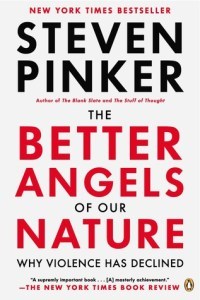 The Better Angels of Our Nature: Why Violence Has Declined by Steven Pinker
The Better Angels of Our Nature: Why Violence Has Declined by Steven PinkerThis is a long book, particularly for someone like me whose reading diet has consisted mainly of children’s and teen books the past few years. It’s 800 pages with small type, and I’ve only made it about 50 pages so far. But those 50 pages have been fascinating. The basic premise of Pinker’s argument is that humans, on the whole, are remarkably less violent than we were millennia, centuries, and even decades ago, and that this trend will likely continue. In the first section of the book, he does a quick rundown of the history of human violence, beginning with what we know of prehistory, continuing through the eras of the Old and New Testaments, and well beyond, until at least the 1950s. The purpose is to show that despite the violence we are all aware of in our current world, it’s actually much less severe and widespread compared to human violence in the past, even the recent past. Knowing how violent humans still are, that makes the recitation of the violent acts – both individual and collective – in our past particularly hard to stomach at times, but interesting nonetheless.
 Guardian of the Horizon by Elizabeth Peters
Guardian of the Horizon by Elizabeth PetersThis is the 16th book in the Amelia Peabody series, and the first one that jumps back in time and tells a “missing” story from between two earlier books. I’m finally into the part of the series that I’ve never read before, either in print or on audio, and it’s been fun to see where the Emerson family went after I stopped reading years ago. This particular story takes the Emersons back to the desert oasis where they first found Nefret. It’s a fun adventure that deviates from the standard mysteries of most of the other installments, and I appreciated the change; it’s kept the series from feeling stale.
November 19, 2020
This Week at Book Riot
For readers who might not know, I’m now into my 18th week of pregnancy (almost half way there!). That means sometimes I simply forget to do things, like do these weekly roundups of my recent writing. Thus, this week’s roundup includes last week’s, too, so it’s a bit long.
Why I still use and love using Goodreads.
2021 book calendars to keep you up-to-date in the new year.
I put together the ultimate guide to book puzzles for your staying-inside winter entertainment.
Pop these book cover posters onto your walls.
How pregnancy books are fantasy reads right now.
10 small midwestern indie bookstores to support this season (all have online ordering!).
Libro.fm’s top audiobooks of 2020.
This is a REALLY fascinating book challenge case: parents are raising concerns over some of the classics used in classrooms because of how they portray racism as an idea of the past. The majority of the parents raising the concerns are Black. Spend some time with this one because it’ll give you some pause (and for what it’s worth, I think the superintendent is being thoughtful and considerate of all sides of this).
Last, but not least, book sweatshirts and hoodies!
November 17, 2020
Long-Awaited Sequels
It’s always fun when an author surprises their readership with a new sequel (or prequel, or companion novel) in a series long thought finished. Here’s a list of some recent YA ones, including some series that began during my childhood – or before!
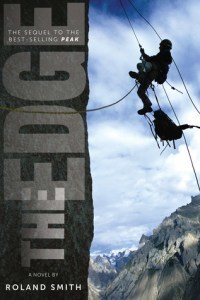 The Edge by Roland Smith – 8 years
The Edge by Roland Smith – 8 yearsSmith first published Peak, the first book in his Peak Marcello series, in 2007, then resumed the series in 2015 with The Edge, creating an 8 year gap. Since then, he’s published two more novels in the series, the latest of which, Descent, was released this year.
Synopsis: Fifteen-year-old Peak Marcello hasn’t climbed since intentionally failing to reach the summit of Mount Everest. He’s been enjoying life at sea level, spending his time with the Two Peas—his younger twin sisters—and being a regular, law-abiding teenager. But then his old climbing buddies, JR, Will, and Jack, show up with an offer Peak may not be able to refuse: the International Peace Ascent. The billionaire Sebastian Plank is recruiting a global team of young climbers to make an inspiring, world-uniting documentary. Peak’s been chosen as the U.S. representative. A part of him wants to stay home and out of the spotlight. But another part is itching to get back out there. In the end, the itch has got to be scratched, and Peak, along with his mom, is helicoptered in to a remote base camp in the Hindu Kush Mountains.
But the trip quickly goes from good time to nightmare. Attacked by an unknown and unseen enemy, some of the climbers are kidnapped—including Peak’s mom. Peak has no choice but to go after them.
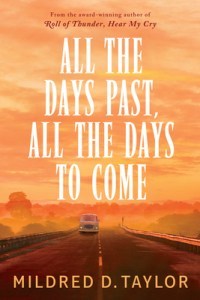 All the Days Past, All the Days to Come by Mildred D. Taylor – 19 years
All the Days Past, All the Days to Come by Mildred D. Taylor – 19 yearsRoll of Thunder, Hear My Cry was first published in 1976, and Taylor periodically wrote others books in the Logan family series every few years through 2001 (The Land). Then came a 19 year break until we were fortunate enough to get the final book in the series this year.
Synopsis: In her tenth book, Mildred Taylor completes her sweeping saga about the Logan family of Mississippi, which is also the story of the civil rights movement in America of the 20th century. Cassie Logan, first met in Song of the Trees and Roll of Thunder, Hear My Cry, is a young woman now, searching for her place in the world, a journey that takes her from Toledo to California, to law school in Boston, and, ultimately, in the 60s, home to Mississippi to participate in voter registration. She is witness to the now-historic events of the century: the Great Migration north, the rise of the civil rights movement, preceded and precipitated by the racist society of America, and the often violent confrontations that brought about change. Rich, compelling storytelling is Ms. Taylor’s hallmark, and she fulfills expectations as she brings to a close the stirring family story that has absorbed her for over forty years. It is a story she was born to tell.
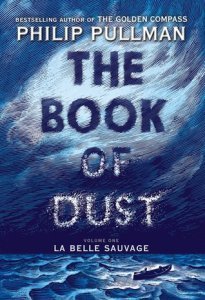 The Book of Dust: La Belle Sauvage by Philip Pullman – 17 years
The Book of Dust: La Belle Sauvage by Philip Pullman – 17 yearsI’ve been waiting for The Book of Dust since at least 2005, when Pullman began speaking about it publicly. The Amber Spyglass, the final book in the acclaimed His Dark Materials series, had been published in 2000, and I absolutely needed more. We finally got the first book in this new trilogy, which takes place when Lyra was a baby, in 2017.
Synopsis: Malcolm Polstead is the kind of boy who notices everything but is not much noticed himself. And so perhaps it was inevitable that he would become a spy…
Malcolm’s father runs an inn called the Trout, on the banks of the river Thames, and all of Oxford passes through its doors. Malcolm and his dæmon, Asta, routinely overhear news and gossip, and the occasional scandal, but during a winter of unceasing rain, Malcolm catches wind of something new: intrigue. He finds a secret message inquiring about a dangerous substance called Dust–and the spy it was intended for finds him.
When she asks Malcolm to keep his eyes open, Malcolm sees suspicious characters everywhere; Lord Asriel, clearly on the run; enforcement agents from the Magisterium; an Egyptian named Coram with warnings just for Malcolm; and a beautiful woman with an evil monkey for a dæmon. All are asking about the same thing: a girl–just a baby–named Lyra. Lyra is the kind of person who draws people in like magnets. And Malcolm will brave any danger, and make shocking sacrifices, to bring her safely through the storm.
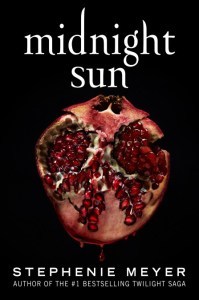 Midnight Sun by Stephenie Meyer – 12 years
Midnight Sun by Stephenie Meyer – 12 yearsMeyer’s last book in her Twilight series, Breaking Dawn, was released in 2008, creating a 12 year gap between that book and Midnight Sun, a retelling of Twilight from Edward’s point of view.
Synopsis: When Edward Cullen and Bella Swan met in Twilight, an iconic love story was born. But until now, fans have heard only Bella’s side of the story. At last, readers can experience Edward’s version in the long-awaited companion novel, Midnight Sun.
This unforgettable tale as told through Edward’s eyes takes on a new and decidedly dark twist. Meeting Bella is both the most unnerving and intriguing event he has experienced in all his years as a vampire. As we learn more fascinating details about Edward’s past and the complexity of his inner thoughts, we understand why this is the defining struggle of his life. How can he justify following his heart if it means leading Bella into danger?
November 15, 2020
Going Global: A Look at International Cover Designs
Cover changes are one of my favorite things to look at since they’re not uncommon in YA books. Not only do I love analyzing why it is that a hardcover design changed when it went to paperback, I also love looking at how cover designs look different around the world. International editions of YA can take on entirely new identities for a number of reasons, including a market that gravitates toward very different design aesthetics in their books, rights acquisition for the design of US covers, or simply the preference of the publisher.
Let’s take a look at five YA books that have some significantly different looks in some of their international editions. These books published between 2019 and 2020. I’ve done the best I can to identify the country for the international edition, but know they might be incorrect, as seeking that information out is even more challenging than finding the US cover designer.
I’ve stuck to one changed design for each of the below, except for the final one, which I’ll showcase three international editions.
I’d love to hear what you think and which is your favorite. I’ve put the US edition on the left, with the alternate cover on the right.
YA International Cover Designs
Diana Urban’s All Your Twisted Secrets takes its cue from the other thrillers on the US YA market, and that’s not necessarily a bad thing. It’ll immediately tell readers whether or not the story i for them. Like so many covers, too, it’s illustrated, with a large, centered title. The cover was illustrated by Evgeni Koroliov, and design direction was by Corina Lupp and Alison Klapthor.
The French edition of this book cover is SO great. It feels absolutely like a twisted mystery, and it mirrors so much of the design of J-Horror films and books, with a hint of old school Lois Duncan books. The title was slightly altered, too, to Who Should Die? I really dig this look.
Both of these covers are so lovely, and they play against each other perfectly. I hadn’t looked at the smaller details of the US version of Kristina Forest’s I Wanna Be Where You Are as closely as I did when I looked at the Indonesian edition — I was going to note that it’s interesting the female lead is driving in that edition, but it looks like she’s in the driver’s seat of the US version, too. I love the two color palates, and I love the clever green-blue color car in both. Even though the way they evoke a dreamy look differs, both succeed in showcasing how this is a story about a girl chasing her dreams.
Cassie Gonzales designed the US cover and worked with artist Alex Cabel. If cover nerdery is your jam, this look behind the process is awesome. I especially love how one of the rejected designs really looks like the Indonesian edition.
There is no question that Abdi Nazemian’s Like a Love Story is set in the city, is there? In the US edition, we have the tall buildings that comprise an urban landscape, while in the French edition, we have the inside of a graffiti-covered subway. Both covers are bright, and both feature three teenagers who are clearly close with one another. More, the story is set in the 1980s and both absolutely reflect that. They’re gritty and showcase the fashion choices of that time and yet, they also feel contemporary.
The US jacket art is by Dave Homer and the design is by Michelle Taormina.
On The Come Up, Angie Thomas’s sophomore YA novel, has such an iconic design on the US cover, and it pairs so well with The Hate U Give. But how striking is the Swedish cover? It’s electric, and even though we don’t have a great view of the model’s body language, her expression and the neon color way is so expressive. This book is electric and propulsive, and the look in that girl’s eyes doesn’t shy away from that.
Cover art for the US edition is by Anjola Coker.
David Yoon’s debut Frankly In Love has so many different international editions and what’s interesting is how they can all both look so different and yet clearly also look like the same book. The US edition in hardcover — which got a new look in paperback — is really simple and eye-catching. It’s all font work. There’s a huge sense of this particular cover looking like adult book covers, suggesting that while the book is YA, the visual marketing of the hardcover angled for those adult readers who like YA, as well as those who might be skeptical of it. I think the paperback is much more teen friendly, but both designs capture a solid feel for the story.
The Italian cover on the right features a teen boy, holding a bouquet of flowers, waiting on a park bench. There’s clearly a romantic angle at play here, though the title font stands out as well. BUT the real reason I wanted to include this cover design is the bit at the bottom which I can’t say I’ve seen before: I don’t read Italian but know enough to translate the words that this book is by the husband of bestseller Nicola Yoon. That’s wild, seeing a male author referred to as the partner of a bestselling female author.
The cover on the left is the Portuguese cover, and I love that it uses such a romantic color selection, as well as a clear indication that romance is a big theme in the story — we see the male lead appearing to look at the person with him adoringly. Finally, the Swedish edition of Frankly In Love is interesting to think about because it carries the same emphasis on being font driven, without any standout images of people on it, but the font work looks nothing like the US edition (Note: I believe this is the Swedish edition, but the title itself appears to be in Danish). And the title? It’s Planet Frank. I love the use of the planet to capture that shift in name.
The US cover artist is Owen Gildersleeve, and you should definitely read this interview about how he created the design. You’ll see how it was replicated on a couple other international editions as well.
Going Globe: A Look at International Cover Designs
Cover changes are one of my favorite things to look at since they’re not uncommon in YA books. Not only do I love analyzing why it is that a hardcover design changed when it went to paperback, I also love looking at how cover designs look different around the world. International editions of YA can take on entirely new identities for a number of reasons, including a market that gravitates toward very different design aesthetics in their books, rights acquisition for the design of US covers, or simply the preference of the publisher.
Let’s take a look at five YA books that have some significantly different looks in some of their international editions. These books published between 2019 and 2020. I’ve done the best I can to identify the country for the international edition, but know they might be incorrect, as seeking that information out is even more challenging than finding the US cover designer.
I’ve stuck to one changed design for each of the below, except for the final one, which I’ll showcase three international editions.
I’d love to hear what you think and which is your favorite. I’ve put the US edition on the left, with the alternate cover on the right.
YA International Cover Designs
Diana Urban’s All Your Twisted Secrets takes its cue from the other thrillers on the US YA market, and that’s not necessarily a bad thing. It’ll immediately tell readers whether or not the story i for them. Like so many covers, too, it’s illustrated, with a large, centered title. The cover was illustrated by Evgeni Koroliov, and design direction was by Corina Lupp and Alison Klapthor.
The French edition of this book cover is SO great. It feels absolutely like a twisted mystery, and it mirrors so much of the design of J-Horror films and books, with a hint of old school Lois Duncan books. The title was slightly altered, too, to Who Should Die? I really dig this look.
Both of these covers are so lovely, and they play against each other perfectly. I hadn’t looked at the smaller details of the US version of Kristina Forest’s I Wanna Be Where You Are as closely as I did when I looked at the Indonesian edition — I was going to note that it’s interesting the female lead is driving in that edition, but it looks like she’s in the driver’s seat of the US version, too. I love the two color palates, and I love the clever green-blue color car in both. Even though the way they evoke a dreamy look differs, both succeed in showcasing how this is a story about a girl chasing her dreams.
Cassie Gonzales designed the US cover and worked with artist Alex Cabel. If cover nerdery is your jam, this look behind the process is awesome. I especially love how one of the rejected designs really looks like the Indonesian edition.
There is no question that Abdi Nazemian’s Like a Love Story is set in the city, is there? In the US edition, we have the tall buildings that comprise an urban landscape, while in the French edition, we have the inside of a graffiti-covered subway. Both covers are bright, and both feature three teenagers who are clearly close with one another. More, the story is set in the 1980s and both absolutely reflect that. They’re gritty and showcase the fashion choices of that time and yet, they also feel contemporary.
The US jacket art is by Dave Homer and the design is by Michelle Taormina.
On The Come Up, Angie Thomas’s sophomore YA novel, has such an iconic design on the US cover, and it pairs so well with The Hate U Give. But how striking is the Swedish cover? It’s electric, and even though we don’t have a great view of the model’s body language, her expression and the neon color way is so expressive. This book is electric and propulsive, and the look in that girl’s eyes doesn’t shy away from that.
Cover art for the US edition is by Anjola Coker.
David Yoon’s debut Frankly In Love has so many different international editions and what’s interesting is how they can all both look so different and yet clearly also look like the same book. The US edition in hardcover — which got a new look in paperback — is really simple and eye-catching. It’s all font work. There’s a huge sense of this particular cover looking like adult book covers, suggesting that while the book is YA, the visual marketing of the hardcover angled for those adult readers who like YA, as well as those who might be skeptical of it. I think the paperback is much more teen friendly, but both designs capture a solid feel for the story.
The Italian cover on the right features a teen boy, holding a bouquet of flowers, waiting on a park bench. There’s clearly a romantic angle at play here, though the title font stands out as well. BUT the real reason I wanted to include this cover design is the bit at the bottom which I can’t say I’ve seen before: I don’t read Italian but know enough to translate the words that this book is by the husband of bestseller Nicola Yoon. That’s wild, seeing a male author referred to as the partner of a bestselling female author.
The cover on the left is the Portuguese cover, and I love that it uses such a romantic color selection, as well as a clear indication that romance is a big theme in the story — we see the male lead appearing to look at the person with him adoringly. Finally, the Swedish edition of Frankly In Love is interesting to think about because it carries the same emphasis on being font driven, without any standout images of people on it, but the font work looks nothing like the US edition (Note: I believe this is the Swedish edition, but the title itself appears to be in Danish). And the title? It’s Planet Frank. I love the use of the planet to capture that shift in name.
The US cover artist is Owen Gildersleeve, and you should definitely read this interview about how he created the design. You’ll see how it was replicated on a couple other international editions as well.
November 5, 2020
This Week at Book Riot
I’ve kept busy at Book Riot this week since it’s helped with the doom scrolling. . .
Here’s a roundup of excellent book socks.
Three recent incidents of vandalism at libraries that host voting or ballot boxes points to voter intimidation.
Parents sue a North Carolina charter school over the use of The Poet X in literature class.
Here’s a whole host of adorable bookish baby clothes.
The Horror Writers Association, Book Riot, Booklist, and United for Libraries are bringing Summer Scares back for 2021.
November 3, 2020
Kimberly’s Third Quarter of 2020 (a bit belated)
In the first part of this year, I made the decision to write about each quarter of my reading here on the blog, which I succeeded with for the first half of the year. And then October happened, and it seemed like everything was both frenzied and dull at the same time. I read very little and wrote even less, so my third quarter post never happened. But I still find the tracking useful, so here I am, a month late, with the summary of my reading life from July – September, wherein I read a total of 15 books.
Seeing a Large Cat by Elizabeth Peters
This was the first book in the Amelia Peabody series that I ever read, many years ago when I was a child on a family road trip. It was the book that made me fall in love with both the Peabody Emerson family as well as Barbara Rosenblat’s audiobook narration. I still love this book. It introduces two interesting characters who become part of the ensemble cast for nearly all future books, and it introduces Ramses’ own POV narration, which adds a newness to the long-running series that I think it needed. It’s funny and absurd and everything works out mostly for the best at the end – just the ticket for this sad and strained time.
The Ape Who Guards the Balance by Elizabeth Peters
This book was notable for me in that it’s really the first time that Amelia’s prejudice toward Egyptians is acknowledged openly as being prejudice. Certainly she was better than most of her time (and better than many today), but when a young Egyptian man whom they had taken in as a member of their extended family falls in love with her British niece and the two wish to be married, Amelia’s first instinct is to object – and she holds to this view for some time. Her husband (who is irritated by everyone equally but does seem to be genuinely free of racial prejudice) brings her round eventually, and Amelia learns of and is ashamed by this unsavory facet of herself. It’s the first time since Book 1 that Amelia’s character grows in any real sense, and it was nice to see.
The Falcon at the Portal by Elizabeth Peters
Well, this book is engaging but extremely sad. If you make it this far in reading the series, I suggest you have the next book, He Shall Thunder in the Sky, close at hand.
Sapiens: A Brief History of Humankind by Yuval Noah Harari
This is one of those books that I can’t stop talking about (probably to the mild aggravation of friends and family). Harari has written an ambitious book about the history of humankind, from 100,000 years ago to the present. Among the most interesting things for me personally were these two bits: there were half a dozen or more different human species that lived at the same time as homo sapiens (not just the Neanderthals as most of us think); and the agricultural revolution may have been ultimately good for 21st century humans, but for most of its duration it actually caused a decrease in the quality of life for most people (not to mention animals). The way Harari frames certain concepts was also fascinating. For example, he writes that what enabled humans to bind together in large groups necessary for modern civilization was our shared belief in myths, and by myths he basically means anything that is not physical. This could be religion, but it’s also abstract ideas like liberalism, democracy, economic systems, and human rights. Without these shared myths, large groups of humans cannot work together across distance and time. I’m excited to read the graphic adaptation that was just published October 27.
Half Way Home by Hugh Howey
I’ve not read anything else by Hugh Howey and I wasn’t particularly impressed by this one. I’m having a hard time even recalling the concept, and I ended up skimming the last third.
He Shall Thunder in the Sky be Elizabeth Peters
This volume concludes the events that began in Falcon at the Portal (albeit three years later for our characters) and sees the villains brought to justice. Satisfying and cathartic.
Cursed: An Anthology of Dark Fairy Tales edited by Marie O’Regan
I enjoyed this short story collection, though I’d be hard pressed to tell you what any of the stories were about. I’m going to blame pandemic brain.
The Companion by Katie Alender
I really enjoyed this gothic-esque YA thriller and wrote a full review of it here.
Heist Society & Perfect Scoundrels by Ally Carter
These were just what I needed in a book for this time: fun, fluffy heist stories of a found family with plenty of banter and love. And of course, happy endings. I own these two and was glad I could re-read them when I needed them.
Tribe: On Homecoming and Belonging by Sebastian Junger
Junger’s short book provides his explanation for why so many white colonists in America willingly abandoned their Western society and culture and went to live with Native American tribes – but there are no records of the reverse ever happening. He weaves this question together with the fact that many American soldiers returning from war have PTSD not only because of the extreme violence they witnessed and participated in, but because of the struggle of leaving behind a communal society (soldiers in war) and trying to reintegrate into an extreme individualist one (modern American society at peace). Certainly he is not arguing that war is good – but the more communal cultures of both the armed forces and Native American tribes exert an inexorable pull on humans. It’s a fascinating book that provides a lot to discuss.
Lord of the Silent by Elizabeth Peters
Another solid entry in this reliably good series.
The Last Confession of Autumn Casterly by Meredith Tate
Autumn Casterly has disappeared, and the only person who believes she hasn’t just run off is her younger sister Ivy. Trapped on the brink of death somewhere, Autumn’s consciousness follows Ivy as she tries to find Autumn. Seasoned readers will know what happened to Autumn years ago that started her down a spiral of dangerous behavior – drug use and dealing, violence – but most of them will still be surprised by the culprits responsible for her kidnapping in the present. This is a thoughtful, often painful read that shines a light on complex sister relationships.
The Fortress by S. A. Jones
Jonathon Bridge offers himself as a supplicant to the Fortress, a protected society of women that exists alongside our modern day world. His wife is requiring this of him in order to remain married after learning of the sexual violence in his workplace and the ways Jonathon was complicit in it (including multiple infidelities). The Fortress has three rules for supplicants: They are forbidden to ask questions, to raise a hand in anger, and to refuse sex. This was a buzzy title at PLA in February, and I picked up it partly because I’ve always been intrigued by matriarchal societies and partly because I wanted to see how it would resolve the issues of consent that its premise raises. It doesn’t. This is a book full of rape that the author and her characters refuse to name as such. The book is interesting to talk about, I suppose, but it’s a really distasteful read without anything meaningful to say.
The Hand on the Wall by Maureen Johnson
I was really irritated after reading the first book in this trilogy, which contains two mysteries – neither of which are resolved in that first volume. Thankfully, this third and final volume wraps everything up nicely. I think I actually enjoyed the second book most, but this is a solid series for mystery readers – one I recommend reading now, when you don’t have to wait a year to learn whodunnit.
November 1, 2020
Fat Girls on 2021 YA Book Covers
Although we’re far from seeing all of the covers of 2021 YA books, it’s been really promising so far. The representation is far more reflective of today’s teens. There is, as always, more room for improvement, but the strides forward are worth pausing to reflect upon.
One area that’s gotten better but is still lacking is the representation of fat teens — and specifically fat girls — on book covers. It shocks me to see casts of characters on a cover, be them illustrated or a photo, and not one of them is not thin. One in five teens is considered obese by CDC guidelines, which are wildly flawed, but that number is a point of reference for how unrepresentative YA book covers and stories about fat teens are.
That all said, what’s positive is how many of the fat teens on YA book covers in 2021 are teens of color. It’s a double win for representation.
Though this roundup focuses on fat female-appearing teens specifically, it was pretty apparent that fat teen boys on YA book covers for next year are even more rare.
I’ve pulled these descriptions from Goodreads, and determination on what makes for a “fat girl” is my own subjective decision. My rule of thumb is that these teens are much curvier than their counterparts or are clearly carrying more fat on their bodies. Of course, if you know of other 2021 covers that have been revealed so far that showcase fat teen girls, I’d love to hear about them in the comments.
My fingers are crossed we see more as more covers are finalized.
Fat Girls on 2021 YA Book Covers (So Far!)
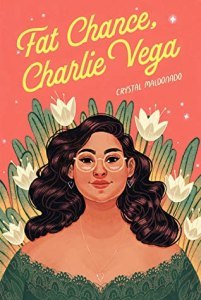 Fat Chance, Charlie Vega (February 2)
Fat Chance, Charlie Vega (February 2)Charlie Vega is a lot of things. Smart. Funny. Artistic. Ambitious. Fat.
People sometimes have a problem with that last one. Especially her mom. Charlie wants a good relationship with her body, but it’s hard, and her mom leaving a billion weight loss shakes on her dresser doesn’t help. The world and everyone in it have ideas about what she should look like: thinner, lighter, slimmer-faced, straighter-haired. Be smaller. Be whiter. Be quieter.
But there’s one person who’s always in Charlie’s corner: her best friend Amelia. Slim. Popular. Athletic. Totally dope. So when Charlie starts a tentative relationship with cute classmate Brian, the first worthwhile guy to notice her, everything is perfect until she learns one thing–he asked Amelia out first. So is she his second choice or what? Does he even really see her? UGHHH. Everything is now officially a MESS.
A sensitive, funny, and painful coming-of-age story with a wry voice and tons of chisme, Fat Chance, Charlie Vega tackles our relationships to our parents, our bodies, our cultures, and ourselves.
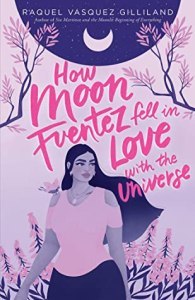 How Moon Fuentez Fell in Love With The Universe by Raquel Vasquez Gilliland (August 10)
How Moon Fuentez Fell in Love With The Universe by Raquel Vasquez Gilliland (August 10)When her twin sister reaches social media stardom, Moon Fuentez accepts her fate as the ugly, unwanted sister hidden in the background, destined to be nothing more than her sister’s camerawoman. But this summer, Moon also takes a job as the “merch girl” on a tour bus full of beautiful influencers and her fate begins to shift in the best way possible.
Most notable is her bunkmate and new nemesis, Santiago Phillips, who is grumpy, combative, and also the hottest guy Moon has ever seen.
Moon is certain she hates Santiago and that he hates her back. But as chance and destiny (and maybe, probably, close proximity) bring the two of them in each other’s perpetual paths, Moon starts to wonder if that’s really true. She even starts to question her destiny as the unnoticed, unloved wallflower she always thought she was.
Could this summer change Moon’s life as she knows it?
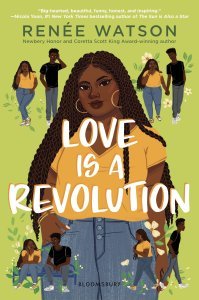 Love Is A Revolution by Renée Watson (February 2)
Love Is A Revolution by Renée Watson (February 2)When Nala Robertson reluctantly agrees to attend an open mic night for her cousin-sister-friend Imani’s birthday, she finds herself falling in instant love with Tye Brown, the MC. He’s perfect, except . . . Tye is an activist and is spending the summer putting on events for the community when Nala would rather watch movies and try out the new seasonal flavors at the local creamery. In order to impress Tye, Nala tells a few tiny lies to have enough in common with him. As they spend more time together, sharing more of themselves, some of those lies get harder to keep up. As Nala falls deeper into keeping up her lies and into love, she’ll learn all the ways love is hard, and how self-love is revolutionary.
In Love Is a Revolution, plus size girls are beautiful and get the attention of the hot guys, the popular girl clique is not shallow but has strong convictions and substance, and the ultimate love story is not only about romance but about how to show radical love to the people in your life, including to yourself.
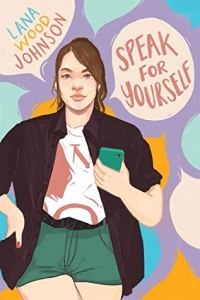 Speak For Yourself by Lana Wood Johnson (June 1)
Speak For Yourself by Lana Wood Johnson (June 1)
Girl meets boy. Girl likes boy.
Girl gets friend to help win boy.
Friend ends up with crush on boy…
Skylar’s got ambitious #goals. And if she wants them to come true, she has to get to work now. (At least she thinks so…) Step one in her epic plan is showing everyone that her latest app is brilliant. To do that, she’s going to use it win State at the Scholastic Exposition, the nerdiest academic competition around.
First, she’ll need a team, and Skylar’s not always so good with people. But she’ll do whatever it takes to put one together … even if it means playing Cupid for her teammates Joey and Zane, at Joey’s request. When things get off to an awkward start for them, Skylar finds herself stepping in to help Joey. Anything to keep her on the team. Only, Skylar seems to be making everything more complicated. Especially when she realizes she might be falling for Zane, which was not a #goal. Can Skylar figure out her feelings, prove her app’s potential to the world, and win State without losing her friends–or is her path to greatness over before it begins?


